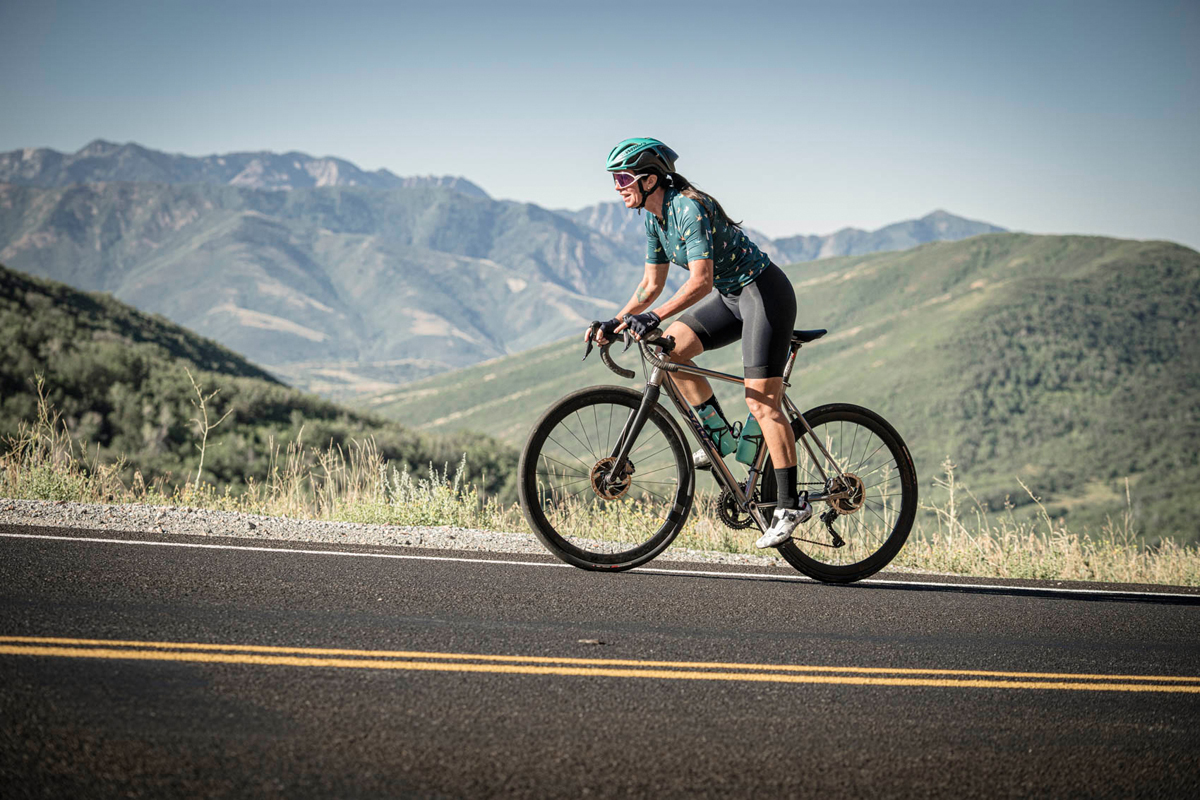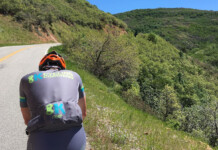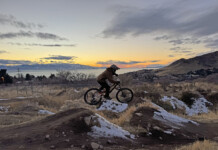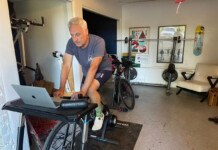By Heather Casey — Maybe you’ve heard this: “A faster climber trains on hills more.” Makes sense, yes? There’s more to riding uphill than simply doing it over and over. Your power-to-weight ratio determines your overall performance when riding up a hill. Power-to-weight ratio has two essential components to know about:
- Power Output refers to the speed and strength of your bike pedals for a sustained time.
- Total Weight refers to the weight of your bike, including clothes, shoes, and things you carry on your bike like hydration, bottles, snacks, and tools.

From the two points above, we can deduce that riding uphill in an improved manner relies on slowly gaining a higher power output or having specific training that will focus on reducing your weight and the bike’s total weight. It’s not an absolute rule to train on hills; whenever you’re out and about on your bike, you can achieve a faster speed while riding uphill.
Reducing Weight Uphill
Reduce Weight of Bike
Are your bike’s components relatively light or relatively heavy? How can you assess whether it’s heavy or light? Try weighing it to find out. Your bike weight, including everything you carry, affects your speed when you ride uphill. For example, Tour De France bikes weigh less than 6.8 kilos or 15 pounds. If you have riding buddies riding even lighter bikes, then best believe they will have the upper hand when you go on riding expeditions together.
Components of your bike that you can tweak and upgrade first are the rotating parts like the wheels, shoes, and pedals, as these will immediately prove your money’s worth. However, take into consideration the costs as well. Spending hard-earned bucks on fancy new wheels will not be worth it if your frame and components do not match the new gear because of their age and weight. Sometimes it’s better to tuck your old bike, use it for other stuff, and upgrade your ride. Ultimately, it’s all up to you to make the more cost-efficient and sustainable choice.
If you lack the money to invest in upgrades, there’s another tactic you can try: Minimizing what you carry on hilly rides will make your bike lighter and smoother. Do you need the two water bottles that you always have with you? How about the big saddlebag full of tools and other miscellaneous items? Maybe it’s better to take one bottle and go for a refill. Choosing lighter apparel could shave one pound and help shift your power-to-weight ratio.
Reducing Weight of Rider
Sometimes, reducing your body weight to increase your cycling speed when riding up hills is better. How much weight loss are we talking about? Imagine this: You can increase your Functional Threshold Power (FTP) by 15 watts simply by having a sleek and intelligently tailored training regime within a 3-month timeframe. Apart from this, you can also achieve a similar effect by working out and losing 7.7 combined pounds from your weight and bike. Doing this would turn you into a significantly faster hill rider, even without improving your power output.
Metabolic Testing is the gold standard in determining an appropriate fueling rate. Losing one pound per week may be realistic by consuming 500 calories less per day or burning the 500 calories through exercise. Doing this daily would earn you at least a pound in weight loss per week. It’s a healthy rate of weight loss that won’t interfere with your overall health.
Improving Your Power Output is a Process
Maybe you feel tired from reading what it would take for you to be a better climber, but remember the idiom “no pain, no gain”? I think its application to sports and our overall health varies, but it also stands true in that there are simply no shortcuts to improve your pedaling power output. Hard work will get you there; training consistently for several months to gain the desired results is worth it.
Before starting a new training program, it’s essential to test your current power output with your preferred method. Doing this will act as your standard and guideline for future improvements you want to try achieving.
Once you have the baseline, there is no other way but up. Diversify your training by including a mix of high- and low-intensity workout sessions that will eventually become more demanding. Aim to ride at least three times per week. Again, don’t expect to achieve your goals overnight. Your improvements will occur slowly. Remember – find your flow, and row, row, row. Or, in this case – pedal, pedal, pedal.
Three months is the least amount of time you’ll need to notice a significant difference in your riding wellness. In this timeframe, expect a considerable increase in your FTP of around 3-5% if your training has been effective. It’s also important to consider whether your sessions are the best path for you to continue taking on. In that regard, here are five more ways to try to ride faster uphill.
5 More Ways You Can Try to Ride Faster Up Hill
Gearing for terrain specificity
- Pace yourself properly so you don’t blow up when you ride uphill. Proper pacing is problematic when you don’t have the appropriate gearing. Giant gears force you to slowly turn the pedals at a high-power output when riding uphill. Enduring this pace can cause muscle micro-trauma and lactate build-up and cause you to fatigue quickly. Setting up easier gears for your bike for hilly rides is better so you can ride at your maximum intensity leisurely without tearing your legs apart. If you have a 53/39 chainring on the front, consider using a 27-, 28-, perhaps even a 32- or 36-tooth cassette in the back. If you have a 50/34 chainring on the front, still consider the option of a 28 or 32-tooth sprocket. Your legs will thank you for it.
- Work on your upper-body strength: When engaging in long rides or competing in multi-day hill cycling events, it’s worth building your strength beforehand. Stress on the upper body increases when you’re riding up hills. Your forearms, shoulders, and entire upper body will soon tire when you have long rides that surge up.
- Has your rolling resistance been checked? Carefully choosing your tires, tire pressure, and wheels can help you save a few precious watts on the bike. Making educated choices will help you have better-rolling resistance for better rides on slopes.
- Aerodynamics: It’s not a big deal when riding up hills, but aerodynamic drag still affects the ride, especially on lower gradients.
- Mechanical resistance: This refers to how efficiently all the moving parts on your bike work. For example, a well-maintained chain might save you a couple of Watts.
Conclusion
To get better at riding faster up hills, acknowledge these facts: improving your power output will push you to the top better, and reducing your overall weight will alleviate a lot of unwanted stressors in your ride. If you can achieve both things together, trust that your hill-climbing on the bike will improve at a rate you never thought possible.
Perhaps the next big thing to consider from all this is the importance of choosing the proper gearing set-up and feeling the route you’ll be riding on when setting up your bike. Several smaller gains will come after that, such as reducing the rolling and mechanical resistance of your bike riding and improving your aerodynamics. Riding faster uphill is hard work, but it’s honest work. And the less time it takes to surge up that slope, the more satisfying your journey.











